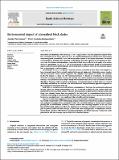Por favor, use este identificador para citar o enlazar a este item:
http://hdl.handle.net/10261/205102COMPARTIR / EXPORTAR:
 SHARE SHARE
 CORE
BASE CORE
BASE
|
|
| Visualizar otros formatos: MARC | Dublin Core | RDF | ORE | MODS | METS | DIDL | DATACITE | |

| Título: | Environmental impact of mineralised black shales |
Autor: | Parviainen, Annika CSIC ORCID; Loukola-Ruskeeniemi, K. | Palabras clave: | Black shales Sulphides Organic carbon |
Fecha de publicación: | 25-ene-2019 | Editor: | Elsevier BV | Citación: | Earth-Science Reviews 192: 65- 90 (2019) | Resumen: | Black shales are sedimentary rocks containing >0.5% of organic carbon. They host polymetallic deposits which have been mined for Cu, Ni, Zn, Mn, P, Mo, V, U, Au and PGE (platinum group elements). Even sub-economic occurrences provide potential risk of acid rock drainage when exposed to oxic surface environment. The natural acid neutralisation potential varies depending on the adjacent rock units, especially on the presence of calcareous rocks. The chemical and mineralogical composition of black shale is reflected in the quality of the surface waters and groundwater. Cu, Ni, Pb, U and Zn are recognised as major pollutants though the environmental impact is characteristically polymetallic just like the black shale occurrences. Hence, the environmental impacts have to be evaluated in each occurrence. The Proterozoic Ni–Zn–Cu–Co deposit at Talvivaara, Finland, is reviewed in more detail as an example of a large, low-grade deposit that is currently exploited with open pit mining and a bioleaching process, together with the Proterozoic Central African Copperbelt, the Cambrian U-Mo deposits in Sweden, the Cambrian Ni–Mo–PGE deposits in China and the Cambrian-Ordovician U deposits in South-Korea, the Devonian Ni–Zn–PGE occurrences in Yukon, Canada, and Kentucky, USA, and the Permian Cu-Ag deposits in Poland and Germany. The mineralised horizons may be merely few centimetres thick like in Yukon or hundreds of metres thick like at Talvivaara. Both natural and anthropogenic environmental impacts of black shales are reviewed world-wide, and based on the overview of the state-of-the-art an integrated research approach is suggested for the comprehensive assessment of the risk. Black shales are natural sources of soil and water contamination. At Talvivaara, the geochemical background includes higher than average concentrations of Ni, Cu, Zn and Mn in glacial till, peat, surface waters and groundwater as well as in stream and lake sediments. Bioaccumulation by plants has been reported in China and Korea. Even endemic diseases have been proposed to be linked with the contamination derived from the weathering and leaching of harmful elements from black shale. Anthropogenic actions exposing the black shale bedrock and associated soils to oxic conditions further intensifies acid rock drainage. Regional or nation-wide mapping of the black shales is recommended to detect potential risk areas. Finland has recently completed the country-wide mapping program of black shales with airborne geophysics integrated with geological, petrophysical and geochemical studies. The black shale database is actively used in regional planning and by environmental authorities, research institutes and consulting companies. In the case of the historical black shale mining areas like in the Kupferschiefer in Germany, restoration measures have been applied to prevent further acid mine drainage. In active and future mining projects, a comprehensive environmental impact assessment with effective monitoring programmes and closure plans play a crucial role in the prevention of acid mine drainage from the black shale -associated deposits. | Versión del editor: | http://dx.doi.org/10.1016/j.earscirev.2019.01.017 | URI: | http://hdl.handle.net/10261/205102 | DOI: | 10.1016/j.earscirev.2019.01.017 | Identificadores: | doi: 10.1016/j.earscirev.2019.01.017 issn: 0012-8252 |
| Aparece en las colecciones: | (IACT) Artículos |
Ficheros en este ítem:
| Fichero | Descripción | Tamaño | Formato | |
|---|---|---|---|---|
| Earth Science Reviews 192 65.pdf | 6,07 MB | Adobe PDF |  Visualizar/Abrir |
CORE Recommender
SCOPUSTM
Citations
55
checked on 16-abr-2024
WEB OF SCIENCETM
Citations
48
checked on 29-feb-2024
Page view(s)
167
checked on 18-abr-2024
Download(s)
397
checked on 18-abr-2024
Google ScholarTM
Check
Altmetric
Altmetric
Este item está licenciado bajo una Licencia Creative Commons

